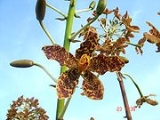
Giant Orchid
Encyclopedia
The Giant Orchid, Grammatophyllum
speciosum, also called Tiger Orchid, Sugar Cane Orchid or Queen of the Orchids, is the world's largest orchid. It is native to New Guinea
, Indonesia
, Malaysia and Philippines
, growing in crotches of large trees on exposed areas of the lowland tropical rainforest
.
It is an epiphytic
and occasionally a lithophytic
plant, forming spectacular root
bundles. Its cylindric pseudobulb
s can grow to a length of 2.5 m. It can grow to gigantic clusters weighing from several hundred kilograms to more than one ton. A Giant Orchid weighing two tons was one of the highlights in the 1851 exhibition at the Crystal Palace
in London
.
Each raceme
can grow to a height of 3m, bearing up to eighty flower
s, each 10 cm wide. The flowers are yellow colored with maroon or dark red spots. These flowers are remarkable, since the lowest flowers have no lip
. It blooms only once every two to four years. This orchid can, however, remain in bloom for up to two months.
Because of its enormous size, it is rarely cultivated.
Grammatophyllum
Grammatophyllum, abbreviated in horticultural trade as Gram, is a genus of 11 orchid species. The name is derived from the Greek words 'gramma' and 'phyllon' , referring to the dark markings in the flower...
speciosum, also called Tiger Orchid, Sugar Cane Orchid or Queen of the Orchids, is the world's largest orchid. It is native to New Guinea
New Guinea
New Guinea is the world's second largest island, after Greenland, covering a land area of 786,000 km2. Located in the southwest Pacific Ocean, it lies geographically to the east of the Malay Archipelago, with which it is sometimes included as part of a greater Indo-Australian Archipelago...
, Indonesia
Indonesia
Indonesia , officially the Republic of Indonesia , is a country in Southeast Asia and Oceania. Indonesia is an archipelago comprising approximately 13,000 islands. It has 33 provinces with over 238 million people, and is the world's fourth most populous country. Indonesia is a republic, with an...
, Malaysia and Philippines
Philippines
The Philippines , officially known as the Republic of the Philippines , is a country in Southeast Asia in the western Pacific Ocean. To its north across the Luzon Strait lies Taiwan. West across the South China Sea sits Vietnam...
, growing in crotches of large trees on exposed areas of the lowland tropical rainforest
Rainforest
Rainforests are forests characterized by high rainfall, with definitions based on a minimum normal annual rainfall of 1750-2000 mm...
.
It is an epiphytic
Epiphyte
An epiphyte is a plant that grows upon another plant non-parasitically or sometimes upon some other object , derives its moisture and nutrients from the air and rain and sometimes from debris accumulating around it, and is found in the temperate zone and in the...
and occasionally a lithophytic
Lithophyte
Lithophytes are a type of plant that grows in or on rocks. Lithophytes feed off moss, nutrients in rain water, litter, and even their own dead tissue....
plant, forming spectacular root
Root
In vascular plants, the root is the organ of a plant that typically lies below the surface of the soil. This is not always the case, however, since a root can also be aerial or aerating . Furthermore, a stem normally occurring below ground is not exceptional either...
bundles. Its cylindric pseudobulb
Pseudobulb
The pseudobulb is a storage organ derived from the part of a stem between two leaf nodes.It applies to the orchid family , specifically certain groups of epiphytic orchids, and may be single or composed of several internodes with evergreen or deciduous leaves along its length.In some species, it is...
s can grow to a length of 2.5 m. It can grow to gigantic clusters weighing from several hundred kilograms to more than one ton. A Giant Orchid weighing two tons was one of the highlights in the 1851 exhibition at the Crystal Palace
The Crystal Palace
The Crystal Palace was a cast-iron and glass building originally erected in Hyde Park, London, England, to house the Great Exhibition of 1851. More than 14,000 exhibitors from around the world gathered in the Palace's of exhibition space to display examples of the latest technology developed in...
in London
London
London is the capital city of :England and the :United Kingdom, the largest metropolitan area in the United Kingdom, and the largest urban zone in the European Union by most measures. Located on the River Thames, London has been a major settlement for two millennia, its history going back to its...
.
Each raceme
Raceme
A raceme is a type of inflorescence that is unbranched and indeterminate and bears pedicellate flowers — flowers having short floral stalks called pedicels — along the axis. In botany, axis means a shoot, in this case one bearing the flowers. In a raceme, the oldest flowers are borne...
can grow to a height of 3m, bearing up to eighty flower
Flower
A flower, sometimes known as a bloom or blossom, is the reproductive structure found in flowering plants . The biological function of a flower is to effect reproduction, usually by providing a mechanism for the union of sperm with eggs...
s, each 10 cm wide. The flowers are yellow colored with maroon or dark red spots. These flowers are remarkable, since the lowest flowers have no lip
Labellum
Labellum is the Latin diminutive of labium, meaning lip. These are anatomical terms used descriptively in biology, for example in Entomology and botany.-Botany:...
. It blooms only once every two to four years. This orchid can, however, remain in bloom for up to two months.
Because of its enormous size, it is rarely cultivated.
External links
- Grammatophyllum speciosum at Orchids Wiki a Orchid Encyclopedia

